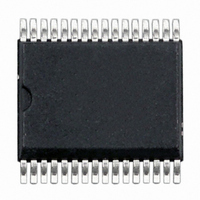CPC5621ATR Clare, CPC5621ATR Datasheet - Page 11

CPC5621ATR
Manufacturer Part Number
CPC5621ATR
Description
IC LITELINK III FULL RING 32SOIC
Manufacturer
Clare
Series
LITELINK® IIIr
Specifications of CPC5621ATR
Function
Data Access Arrangement (DAA)
Number Of Circuits
1
Voltage - Supply
3 V ~ 5.5 V
Current - Supply
9mA
Power (watts)
1W
Operating Temperature
-40°C ~ 85°C
Mounting Type
Surface Mount
Package / Case
32-SOIC (7.5mm Width)
Includes
Caller ID Signal Reception Function, Full-Wave Ring Detection
For Use With
CLA165 - LITELINK III EVALUATION BOARDCLA164 - LITELINK III EVALUATION BOARD
Lead Free Status / RoHS Status
Lead free / RoHS Compliant
Interface
-
Other names
CLA321TR
CPC5621ATR
CPC5621ATR
Available stocks
Company
Part Number
Manufacturer
Quantity
Price
Part Number:
CPC5621ATR
Manufacturer:
LITELINK
Quantity:
20 000
The ringing detection threshold depends on the values
of R3 (R
C7 (C
components shown in the application circuits are
recommended for typical operation. The ringing
detection threshold can be changed according to the
following formula:
Where:
•
•
•
•
Clare Application Note AN-117
and Ring Detect Voltage Threshold
trying different component values in this circuit.
Changing the ringing detection threshold will also
change the caller ID gain and the timing of the polarity
reversal detection pulse, if used.
3.2.2 Polarity Reversal Detection with
The full-wave ringing detector in the CPC5621 makes
it possible to detect on-hook tip and ring polarity
reversal using the RING output. When the polarity of
tip and ring reverses, a pulse on RING indicates the
event. Your system logic must be able to discriminate
this single pulse of approximately 1 msec (using the
recommended snoop circuit external components)
from a valid ringing signal.
3.2.3 On-hook Caller ID Signal Reception
On-hook caller ID (CID) signals are processed by
LITELINK by coupling the CID data burst through the
snoop circuit to the LITELINK RX outputs under
control of the CID pin. In North America, CID data
signals are typically sent between the first and second
ringing signal.
In North American applications, follow these steps to
receive on-hook caller ID data via the LITELINK RX
outputs:
1. Detect the first ringing signal outputs on RING.
2. Assert CID low.
3. Process the CID data from the RX outputs.
R04
V
RINGPK
R
data sheet.
RSNP
the application circuits shown in this data sheet.
C
this data sheet.
And ƒ
SNPD
SNP
SNP-
CPC5621 in On-hook State
= C7 = C8 in the application circuits shown in
RING
TOTAL
SNPD
=
= R3 in the application circuits shown in this
), and C8 (C
⎛
⎝
750mV
---------------- -
R
is the frequency of the ringing signal.
), R6 & R44 (R
SNPD
= the total of R6, R7, R44, and R45 in
⎞
⎠
(
SNP+
R
SNP
). The value of these
TOTAL
SNP-
Customize Caller ID Gain
+
is a spreadsheet for
), R7 & R45 (R
R
SNPD
)
2
+
------------------------------------- -
(
πf
RING
SNP+
1
www.clare.com
C
SNP
),
)
2
4. De-assert CID (high or floating).
Note: Taking LITELINK off-hook (via the OH pin)
disconnects the snoop path from both the receive
outputs and the RING output, regardless of the state
of the CID pin.
CID gain from tip and ring to RX+ and RX- is
determined by:
Where:
•
•
•
•
The recommended components in the application
circuit yield a gain 0.27 dB at 2000 Hz. Clare
Application Note AN-117
Ring Detect Voltage Threshold
different component values in this circuit. Changing
the CID gain will also change the ring detection
threshold and the timing of the polarity reversal
detection pulse, if used.
For single-ended receive applications where only one
RX output is used, the snoop circuit gain can be
adjusted back to 0 dB by changing the value of the
snoop series resistors R6, R7, R44 and R45 from
1.8MΩ to 715kΩ. This change results in negligible
modification to the ringing detect threshold.
3.3 Off-Hook Operation: OH=0
3.3.1 Receive Signal Path
Signals to and from the telephone network appear on
the tip and ring connections of the application circuit.
Receive signals are extracted from transmit signals by
the LITELINK two-wire to four-wire hybrid. Next, the
receive signal is converted to infrared light by the
receive photodiode amplifier and receive path LED.
The intensity of the light is modulated by the receive
GAIN
R
sheet
RSNP
the application circuits in this data sheet
C
sheet
and where ƒ is the frequency of the CID signal
SNPD
SNP
CID
= C7 = C8 in the application circuits in this data
TOTAL
(
= R3 in the application circuits in this data
dB
)
=
= the total of R6, R7, R44, and R45 in
20
log
------------------------------------------------------------------------------------------------ -
(
R
Customize Caller ID Gain and
SNP
is a spreadsheet for trying
TOTAL
CPC5620/CPC5621
+
6R
R
SNPD
SNPD
)
2
+
------------------------- -
(
πfC
1
SNP
11
)
2
















